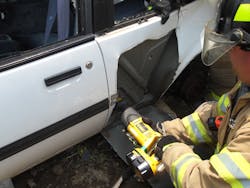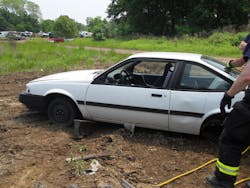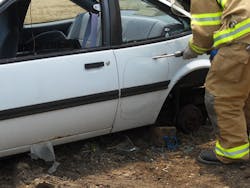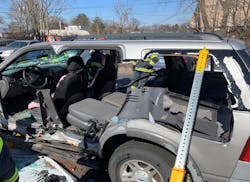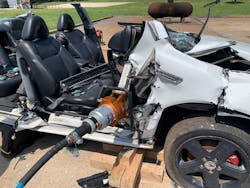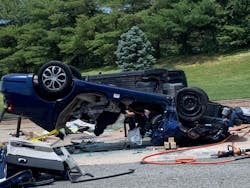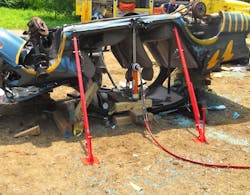Maximum Access: Efficient Extrication Techniques for Making Space
Working within the “Golden Hour” and the “Platinum Ten” arena requires vehicle extrication operations to be quick, deliberate and safe. Four skills in particular can help rescuers to succeed on all three counts.
That said, keep in mind that these skills come into play only after numerous other steps already are completed: stabilization is established/on-going; the incident scene is secured; power supply to the vehicle(s) is secured; glass is removed where necessary; and patient care has commenced. Furthermore, the damage to the vehicle could require significant displacement of the vehicle’s components and would benefit from a wider access area for the patients; in some cases, it might require medical treatment and displacement operations to occur simultaneously.
Two-door vehicles have limitations when it comes to rear seat access. There are times when accessing a patient in the rear seat area requires some unconventional thinking. Normal access for passengers to pass between the B-pillar and the front seat when getting to the rear seat won’t work when removing an injured patient (Photo 1). Therefore, you must make another access point, or “third door,” in the vehicle. Here, we combine removing the door along with the rear seat panel to save time and increase accessibility.
Full side removal
Four-door vehicles pose a stabilization problem for rescuers when it comes to patient care. Medical personnel might be required to manipulate cervical stabilization around a displaced B-pillar in an accident. Furthermore, side-impact collisions might hinder access to center-door striker assemblies and hinge areas on sedans. It might be best to remove the entire side of the vehicle in one maneuver.
Begin at the Nader pin/door striker assembly area for the rear door and displace the door from the connection. Next, the cutters are utilized to cut completely through the top of the B-pillar and to place a relief cut in the bottom of the B-pillar, parallel to the rocker channel. Be sure to cut the seat belt, so the belt doesn’t hinder the removal of the post.
There is debate about which cut to make first on the B-pillar, the top cut or the displace the relief cut. It has been my experience that the B-pillar displacement works much better when the top of the pillar is cut prior to displacement.
After the B-pillar is displaced from the vehicle, spread or cut the front door hinges, removing the entire side panel assembly from the vehicle (Photo 6). Be sure to have wire cutters on hand to cut any wiring for power accessories that might be in the door assemblies.
High dash displacement
Front-impact collisions can compound the problems that are found on the extrication scene. When two vehicles collide while traveling in opposite directions, the impact force can be increased exponentially. Moreover, recently, high-speed frontal collisions have resulted in more footwell entanglements, including pedal entanglement and lower firewall intrusion with the patient’s lower extremities. Additionally, when the vehicles come to rest, the front of the passenger compartment might be pushed down on the occupants, which hinders access. Furthermore, when the vehicle is up against a stationary object, it’s exceedingly difficult to displace the dashboard and firewall assembly off of the occupants. In this case, the high dash displacement is successful for disentanglement, because it allows for displacement without driving the front of the vehicle downward or into the object that the vehicle rests against.
(To execute this maneuver, the doors on the patient’s side of the vehicle must be removed, and the roof assembly must be either rolled back or removed completely.)
Make two parallel cuts into the A-pillar, one directly above the lower hinge and one directly below the lower hinge. Two more cuts are crucial in performing this maneuver: One cut is made from the lower side of the front wheel well, just behind the center of the wheel well, and the other cut is made from the top of the fender area, just behind the shock absorber/strut tower. Note: A structural metal fender channel is located in the vicinity of the top cut area, between the fender and the hood. It’s vital that this channel is cut through completely, or the dashboard won’t successfully displace.
Once these relief cuts are made, spreaders are used to first clamp onto the area that’s between the two parallel cuts in the lower hinge area and then bend the material out of the way. This allows for a large purchase point for the spreader tips to be set into place. At this time, additional cribbing/support should be put in place below the A-pillar, so the bottom of the channel doesn’t displace (Photo 7). The spreaders then are opened slowly, being sure to keep the handle of the tool parallel to the ground or tilted upward slightly. This increases the tool’s capability to lift the dashboard, instead of deflecting the lower region of the A-pillar outward. Lifting the A-pillar displaces the dashboard area while pivoting the fender assembly at the relief cut in front of the strut tower.
Inverted roof removal
Consider this: A vehicle extrication involves a vehicle that resulted in an inverted position (roof down) because of a significant rollover. Now, consider that the force of the impact to the ground caused the roof posts to completely fail, which compromises the passenger compartment significantly. Even after the doors are removed, there still might be limited room to access the patient. It might be necessary to remove the entire roof assembly from underneath the vehicle to access and remove the patient safely.
Stabilization is key here: The vehicle no longer will rely on the roof/pillars assembly to hold up the vehicle. The application of stabilization should be based on equipment availability and the direction of patient travel. If the patient is coming out of the vehicle through the rear window area, stabilization in that path of travel would be counterproductive.
If your department relies heavily on cribbing instead of struts and A-frame stabilization, your opportunities might be driven based on the limitations of your equipment. Either way, the significance of stabilization during this operation can’t be overstressed; it will make or break your operation.
Being proficient on the rescue scene isn’t based upon brute strength alone. A high level of knowledge and understanding regarding the capabilities and limitations of all of the equipment that’s in the tool cache is what leads to success at the incident (Photos 9 and 10).
It’s highly advisable to practice these skills on vehicles. Having the time and resources available to apply these skills prior to the emergency will increase the effectiveness and efficiency of the company when it’s called to respond.
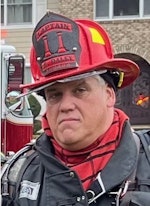
Michael Daley
MICHAEL DALEY, who is a Firehouse contributing editor, is a 37-year veteran who serves as a captain and department training officer in Monroe Township, NJ. He is a staff instructor at multiple New Jersey fire academies and is an adjunct professor in the Fire Science Program at Middlesex County College. Daley is a nationally known instructor who has presented at multiple conferences, including Firehouse Expo and Firehouse World. His education includes accreditations as a Chief Training Officer and a Fire Investigator, and he completed the Craftsman Level of education with Project Kill the Flashover. Daley is a member of the Institution of Fire Engineers and a FEMA Instructor and Rescue Officer with NJ Urban Search and Rescue Task Force 1. He operates Fire Service Performance Concepts, which is a training and research firm that delivers and develops training courses in many fire service competencies.
